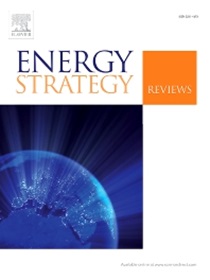能源流动及其强度分析——以中国180个省际部门为例
IF 7.9
2区 工程技术
Q1 ENERGY & FUELS
引用次数: 0
摘要
本文对中国180个省际部门的能量流及其强度进行了深入的定量分析。为此,本研究基于改进的假设提取方法和多区域投入产出模型,提出了区域间部门能源消费净流模型和区域间部门能源净流强度模型。研究结果表明,山东建筑业、江苏建筑业和浙江工业是前三大能源接收省,净输入总量分别为6054 × 104吨煤当量、5259 × 104吨煤当量和5171 × 104吨煤当量。此外,内蒙古、山东和河北的工业是前三大能源供应商,总产值分别为12073 × 104吨煤、11374 × 104吨煤和10455 × 104吨煤。此外,研究发现,青海省(- 4.46 tce/万元)、新疆省(- 3.32 tce/万元)和山西省(- 3.14 tce/万元)的跨省部门建筑能源净投入强度影响最大。相比之下,青海工业(3.06 tce/万元)、新疆工业(2.95 tce/万元)和云南交通运输(2.39 tce/万元)的省际部门能源净产出强度在中国180个省际部门中具有显著作用。本文章由计算机程序翻译,如有差异,请以英文原文为准。
Analysis of energy flow and its intensity: A case study from China's 180 inter-provincial sectors
This study conducts a thorough quantitative analysis of energy flow and its intensity in 180 inter-provincial sectors of China. To achieve this, this study proposes two models based on the modified hypothetical extraction method and multi-regional input–output model, namely, an inter-regional sectoral energy consumption net-flow model and an inter-regional sectoral energy net-flow intensity model. The findings reveal that Construction in Shandong, Construction in Jiangsu, and Industry in Zhejiang are the top three energy receivers, with total net-input values of 6,054 104 ton of coal equivalent (tce), 5,259 104 tce, and 5,171 104 tce, respectively. Additionally, Industry in Inner Mongolia, Shandong, and Hebei are the top three energy suppliers, with total net-output values of 12,073 104 tce, 11,374 104 tce, and 10,455 104 tce, respectively. Furthermore, the study finds that the inter-provincial sectoral energy net-input intensity of Construction in Qinghai (−4.46 tce/ten thousand yuan), Xinjiang (−3.32 tce/ten thousand yuan), and Shanxi (−3.14 tce/ten thousand yuan) had the largest influence. In contrast, the inter-provincial sectoral energy net-output intensity of Industry in Qinghai (3.06 tce/ten thousand yuan), Industry in Xinjiang (2.95 tce/ten thousand yuan), and Transportation in Yunnan (2.39 tce/ten thousand yuan) have significant roles in China's 180 inter-provincial sectors.
求助全文
通过发布文献求助,成功后即可免费获取论文全文。
去求助
来源期刊

Energy Strategy Reviews
Energy-Energy (miscellaneous)
CiteScore
12.80
自引率
4.90%
发文量
167
审稿时长
40 weeks
期刊介绍:
Energy Strategy Reviews is a gold open access journal that provides authoritative content on strategic decision-making and vision-sharing related to society''s energy needs.
Energy Strategy Reviews publishes:
• Analyses
• Methodologies
• Case Studies
• Reviews
And by invitation:
• Report Reviews
• Viewpoints
 求助内容:
求助内容: 应助结果提醒方式:
应助结果提醒方式:


